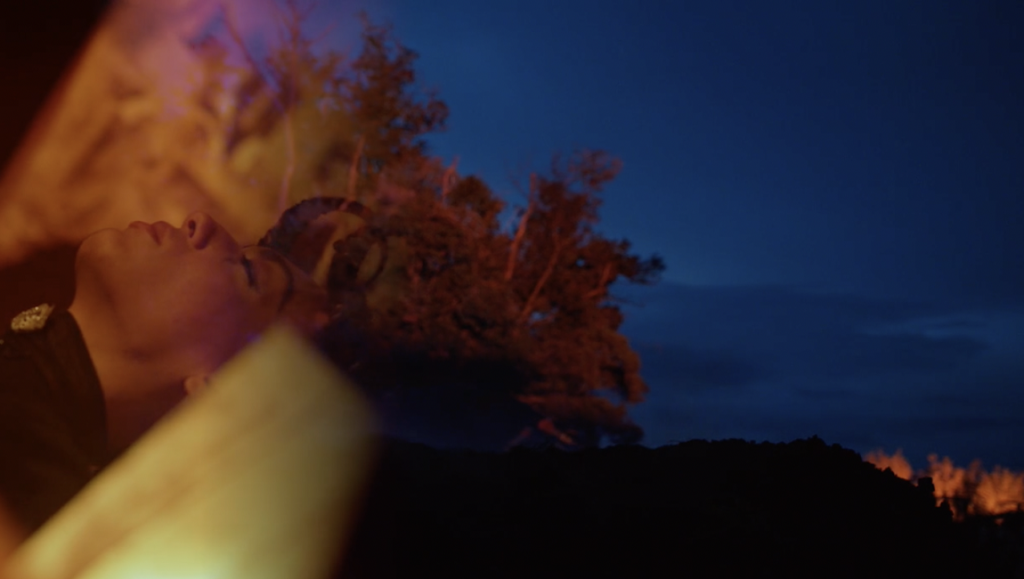Originally part of a broader exhibit by filmmaker/artist/performer/sculptor Wu Tsang, held in Berlin’s Gropius Bau in 2019, one emerging from a point of view stands on its own as a mysterious and rich work. But knowing the exhibit’s title informs the film — set on Lesbos, a hub for refugees trying to reach mainland Europe during the migrant crisis — in an interesting way. Specifically, it brings a certain level of suspicion to the people she interviews about the situation, to the photojournalist trying to capture it, and, most importantly, to herself as a filmmaker.
Perhaps this is why Tsang chose to make a film that isn’t exactly about this crisis, but one that orbits and resonates with it. All three of the film’s present-day strands — most literally the perspectives of onlookers, the journalist, and the people of Lesbos — observe from a distance, while its fictional scenes that follow Yassmine, a witch whose mythological story is materially the furthest from the crisis but actually feels the closest, address the subject at hand more abstractedly. However, real connection between threads is made by interweaving them; not by establishing any clear unity, but instead by locating the meaning between them. While Yassmine mostly stays on one side of the screen and the photojournalist on the other, they aren’t harshly divided; each takes up two-thirds of the frame, so even when they don’t share the screen, they overlap.
This plays into one of Tsang’s major interests: liminality, that mysterious, fertile space between things that she sees, even when they may seem literal or self-evident. In Into a Space of Love (2019), her collaboration with Frieze and Gucci, she characterizes the evolution of House music in the New York underground as much as a spiritual continuum as something defined by a material place and culture. By standing at this exact intersection of people, place, and time, these elements are able to channel something entirely different that transcends the difficult realities that defined the culture. This is what Tsang aims to do with the intersecting strands and genres in one emerging, especially as they start to bleed into gorgeous collages, the images blending together in precise yet dreamlike ways. Something new emerges from the strange harmonies and frictions therein, unlike a conventional documentary, which so often carves real life into the shape of art or, more often, content.
But to say that Tsang has totally transcended “subject” in her film isn’t exactly true. While Yassmine’s scenes don’t refer to the refugees, they strongly parallel them. This can be quite beautiful, like when Yassmine’s death dream brings her close to a man in the real world, where whatever he’s digging seems to become not just a grave for her, but a grave for everyone who passes through Lesbos and didn’t make it, the people he talks about trying his best to help. But it’s much less effective to compare Yassmine’s hope — for a King to come and save her from a cruel and isolating home life — to refugees who are trying to escape war. To compare the arrival of refugees in places like the UK — which, at best, don’t care whether such individuals live or die — to Yassmine’s betrayal by the King for whom she wished is to diminish the weight of the former.
Trying to evoke without seeming flippant or reductive is a challenge inherent to making a film about something that’s being rendered as implicit. For all these problems, one emerging does tend toward clarity and is emotionally effective. However, when Yassmine, who walks straight into the ocean after being magically revived, dances amongst the constellations of sea life that mirror the boats traveling through the night, it becomes clear that she cannot do what the refugees are doing — she gives up on life. What is much harder, as one interviewee observes, is to keep going. In breaking the parallels, Tsang acknowledges the limits of her methods, and reaches across them to a certain extent, managing the feat without shoving a camera into someone’s face and projecting something onto it. If there is no non-violent way to look at somebody, there might at least be a non-violent way to resonate with them.
Published as part of InRO Weekly — Volume 1, Issue 18.


Comments are closed.